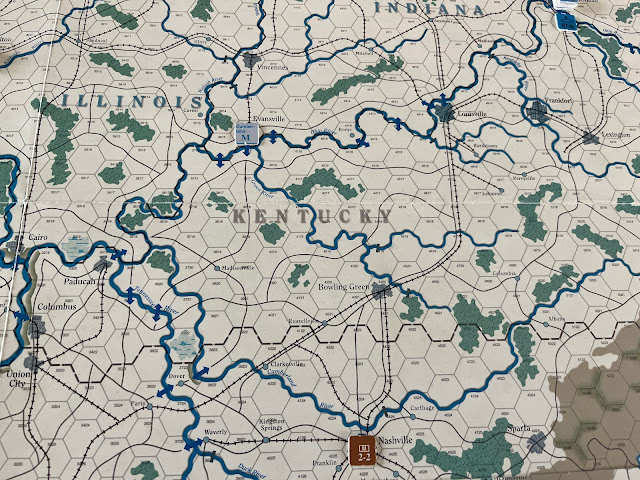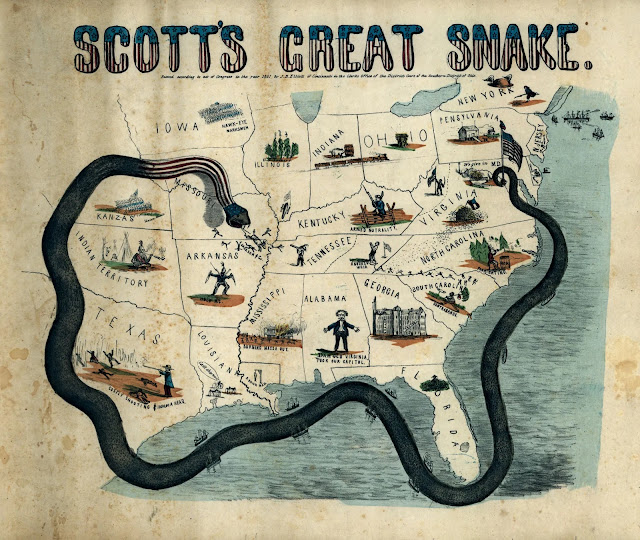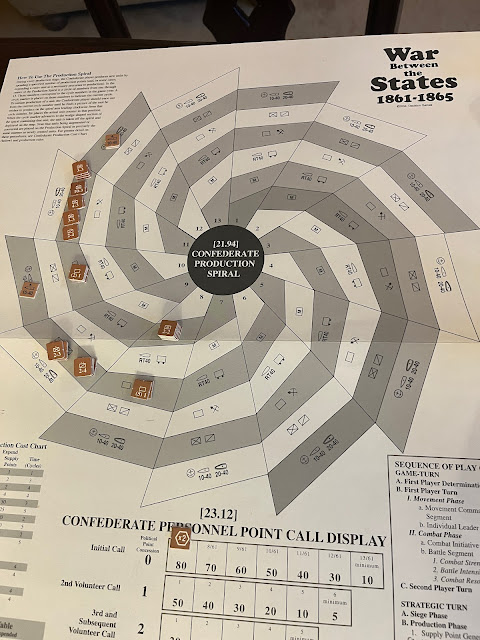"You are green, it is true, but they are green, also; you are all green alike"
Abraham Lincoln to Irvin McDowell July 1861.
The first step is to draw initiative chits for each side for the turn. Each side will have a guaranteed number of force moves (which might include a leaders command) and then is able to roll against an individual leader's "initiative" to determine whether additional forces can move. A division or other counter not directly controlled by a leader counter will need to use one of the chit moves in order to get about. Naval movement does not require initiative and Naval transports (River or Blue Water) can transport up to ten strength points for 40 hexes on the rivers and 50 hexes at sea.
From 7/61 to 6/62 the initiative chit pool each turn is very small - 0,1, (2) & 3. It does increase through the war but fluctuates during e.g. Winter. There is an option for the confederates to always take the number in parenthesis rather than risk a blind pick. I think I will adopt that rule which models a somewhat sclerotic Union strategic command. If the confederates take "2" at the start of a phase they will usually (2/3 of the time) move first with the union having 1 guaranteed initiation or none at all. Rarely (1/3 of the time) the union will move first with 3 guaranteed chit force moves - representing finally say McDowell or Burnside deciding to succumb to pressure and get on with it. The initiative then of individual leader counters then becomes very important. Planning and the resources for it are very finite. It took the Union four years to conquer in effect an area the size of Western Europe and eventually required 2.2 million men at arms to be called up or volunteer for the Union over that period.
Confederate Initial Strategy
I do not think at this stage that the confederates have sufficient strength to attempt to "invade" the North. While Kentucky is a strategic prize for the confederacy the price of breaching Kentucky neutrality is probably too high. The Union would receive fully three times as many Personnel points from the State population as the confederacy in that instance. In some ways Kentucky can act as a "buffer" and the Union faces the same jeopardy of gifting the confederacy a large amount of additional Personnel points.
It might be useful for the confederates to bring any straggling units into supply as best they can and to look to shore up the defences of the Mississippi in particular and other "borders" and seaports. New Orleans needs more than its small garrison to defend itself. In addition some forward deployment of units to Union City in Tennessee might be useful. Historically the confederates entered Kentucky expecting the local population to rise up which it failed to do in any large numbers. I will leave well alone for now and let the Union make the mistake of disaffecting the Kentucky legislature. Missouri though and St. Louis remain a tempting target.
In many ways the confederates can adopt a strategy of seeking to hold what they have and perhaps to "dig in" in as many places as are possible for the longer term defence of the new nation. Things are not going to unfold with any great pace even with 2 guaranteed force initiations a week across the 4 turn cycle of the month. Are we heading inexorably to a repeat of first Manasasses (with all the painting that requires !).
Union Initial Strategy and Logistics
The victory/political point clock (see my description here) begins ticking for the Union which has a year to capture 4 key confederate cities East of the Mississippi failing which the Confederates will begin to accumulate political points which could allow recognition or even an outright victory. A continuous assault will need to be maintained on Richmond tying down large numbers of troops of the Confederacy in the Virginia theatre. Rather than maintain a single point of pressure it might be useful to attack both frontally on Richmond as well as down the Peninsular from Fort Monroe and possibly even through the mountains of West Virginia flanking Richmond and the confederacy. McLennan is based in Cincinnati and his leader counter is currently the best on the board in terms of his Command Span and Combat Ranking for morale on the tabletop. He is stymied with a low initiative of 1 so nothing is going to move very fast much to Lincoln's dismay unless the priority chit moves are used - on that basis maintaining McDowell in command in the Virginia theatre is acceptable.
The "target" cities (of which 4 are needed by 8/63 include cities on the Mississipi such as Memphis and Vicksburg as well as strategic cities along the Cumberland and Tennessee rivers such as Nashville, Chattanooga and Knoxville. Further in that valley area in Tennessee there is the strategic railroad from Lynchburg to Cleveland Tennessee. It may be difficult to supply such an army operating in the interior of the Confederacy without developed logistics.
Supply is traced through operative and owned railroads navicable rivers and coastal hexes from Departments. Supply Depots and train can also dispense supply to nearby units - so in effect operating as forward operating bases for campaigning armies. Movement in the interior will require careful thought. I have read up the rules on railnets, rail cuts and also the broadcast of supply using neutral railroads in Missouri and Kentucky which should help the both sides to a degree.
Lyons is sat in Missouri with Price 100 miles to the South West in Rolla. Lyons currently has the forces to take on Price and actually with an initiative
Finally there is the temptation (as the Union did) to secure base of operations on the Confederate coastline. A seaborne campaign for example against targets such as New Orleans or Charleston.
What is clear is that across 4 turns of July the Union may only receive perhaps 3-5 chit moves in total as an average and probably very spread out (3 or 1 being the only two possible draws or value). It is probably best to focus on developing one strand of strategy through July.
So is it to be "On to Richmond" to begin applying pressure to the Union from the outset or a subtler more nuanced approach ? What is clear is the strategy that won eventually was one that required extended logistics and multiple axise of attack. Ultimately seizing Richmond would be a huge blow but it is unlikely to be possible on the tabletop for quite some time. I think the political pressure from Abraham Lincoln would be impossible to ignore. I think I have a crash painting exercise to undertake if 60,000 men are to clash in Northern Virginia in July. Nothing will move them if the Union fails in its chit draw and the McDowell fails his initiative roll !
Chit Draw - 7/61
Confederate elect to take 2 - 2 forces may automatically have initiative and after that unused leaders may roll. Automatic moves must occur before initiative rolls are determined.
Union draws 0 - no automatic force initiative.
Confederates to move first
Confederate Moves
(1) Confederate M2 counter on 1609 moves to join second militia counter on 1612 just below 1611 Franklin West Virginia.
(2) Initiate Force with Polk***(2-1) at B2802 Memphis
A *** General without a headquarters can command two divisional counters under the optional historical leaders rules. Those units do not have to move in concert but can disperse. The initiative allows separate orders.
3021 New Madrid is of no strategic importance to the Confederates other than its position on the Mississippi. Union City at the far NorthWest of Tennesee is also on the Mississippi but commands a four way rail junction bordering on Kentucky and sits astride the road to Memphis. 3013 next door is also a prime candidate for a fortress as it sits on some bluffs overlooking the river. Historically there were a number of defensive works at this position on the Mississippi including the famous Island Number 10. The M2 counter on New Madrid cannot move to Union City using the Ferry Crossing to Columbus as this would violate Kentucky neutrality - a subject discussed at length earlier in this post and prior posts. It seems difficult to make a river crossing within the movement allowance.
Thankfully the River Transport unit at Memphis can just about operate to move the I3 unit to Union City. The RT has to pay 10 to embark and disembark troops from its allowance and the distance in water hexsides from the Ferry at Memphis is 20 (total 40). For the I3 unit at Memphis embarking at a Ferry costs 1 movement point and disembarking at a clear hex (Union City is not a "port or base") costs 2 points. There is a separate embarkation and disembarkation points cost table that I have missed before when playing.
Polk himself can move to Union City by Road or Rail but will accompany his C2 cavalry at a cost of 2 rail points for the cavalry from the Confederates award of 10 for the turn. Leaving now I3, C2 and Polk at Union City.
Price at Rolla in Missouri fails an initiative roll which could prove costly. There is no need for Magruder commanding an I4 unit on the peninsula to move. He is man-marking Butler at Fort Monroe. Butler has an initiative of "0" and the union has scored "0" this turn on chit moves. He is therefore moribund and cannot advance up the peninsular as he has no motivation or orders ! This information would be available in a two player game. To my mind the porous state of information on a board without fog of war and clarity of ones own divided intentions when playing solo models the state of clear information and gossip about troop movements for much of the war. At the outset of the war the papers in Washington clearly broadcast the intention of the army to a frontal assault on Richmond.
There is a possibility of concentrating all or part of Joe Johnstons force now with the main force of Beauregard at Manassas junction. Any Union force advancing to Richmond would have to deal with a consolidated land army of more like 30,000 than 20,000 men. Joe Johnston rolls 6 and fails his initiative this turn in any event.
This concludes the Confederate moves and the Rail Points are reduced by 2 for the cavalry rail movement from Memphis to Union City.
Union Moves
The Union is restricted to initiative moves only by leaders.
McDowel (2), McLennan(1) and Butler (0) fail initiative tests - automatically in Butler's case ! Heintzelman (2) who was newly placed in Evansville, Illinois also fails a test.
I wanted to bring Heintzelman to Missouri to give greater options for a campaign in that small theatre against Price. There for example an I3 counter out on a limb at Jefferson City that could outflank Price's forces while a main assault take place from ...
Lyons**(4-2) - the martyr of Wilson's Creek on August 10th 1861. Lyons passes his initiative and can command a division and a brigade as a ** leader. It is time to take the fight to Price. The regular 2nd US army regiment (I3 - 6-5 and not PT NE) moves out together with the US regular cavalry (C1 - Cav 2-5). The Missouri railroads can be used by either side while Missouri is neutral. The union uses 4 rail points to move Lyons' regular forces which detrain in Missouri farmland outside of Rolla at A2114.
A further initiative throw will be required to initiate combat. A "4" again on a D6 - Lyons is able to attack Price at Rolla. By luck or judgement I have a small opening battle between Lyons and Price which I can get on the table relatively easily.
The two Orders of Battle will be as follows :-
Union - Lyons Command - Exhaustion 5
Lyons - Divisional Commander - "2" Combat rating (I will remind myself how to deal with this on the tabletop but Lyons should get some sort of advantage over Price for morale purposes).
2nd US Infantry M5 [ ] [ ] [ ] [ ] [ ] [ ]
US Cavalry Brigade M5 [S] [S] (Treat as Light Cavalry rule 23.1.1 V&B RtGlory - Breach loading carbines)
Artillery Brigade - SB-F PT M5 [ ] [ ]
Confederate - Price Command - Exhaustion 5
Price - Divisional Commander - "1" Combat Rating
Militia Regiments (1) M4 PT NE [ ] [ ] [ ] [ ]
Militia Regiments (2) M4 PT NE [ ] [ ] [ ] [ ]
Confederate Militia Cavalry Regiments (1) M5 PT [S] [S] (Treat both brigades as Light Cavalry 23.1.1 V&B RtGlory - Muzzle loading carbines)
Confederate Militia Cavalry Regiments (2) M 5 PT [S] [S]
Artillery Brigade SB-F M5 [ ] [ ]
This is fantastic small painting and terrain project to complete to kick off the campaign on the tabletop. I have the option to double up the scale using the Volley and Bayonet telescoping system so that e.g Price's command becomes perhaps 8 regimental bases. I may however keep it simple and just play the battle on a small 4 x 4 table with the Confederates drawn up in and around Jefferson and the Union forces seeking to eject them from the town. I can also have some fun naming individual militia regiments and minor commanders on the field.
I am wondering whether I should have perceived the threat and withdrawn the confederates back to Jefferson City but Ultimately that would have not been like Price who has already hatched a plan to steal the Missouri militia artillery and to rouse the local militia. Price could not move however due to his low initiative and the confederates had strategic priorities elsewhere. Lyons has demonstrated as he did in August 1861 that he is on the front foot. I will play out this battle over the next week.
There is one more rule point I should cover as transfer from the counters to the tabletop. I am not going to treat Militia counters in the boardgame with all of the Militia rules for the tabletop from Volleys & Bayonet. Militia in Volley and Bayonet suffer a permanent disorder from the beginning and as such will rout as soon as they receive a second disorder marker. I have looked through all of the scenarios I could find online for ACW Volley and Bayonet and the Volley and Bayonet House Divided campaign. It doesn't seem that that scenario writers are hampering early war units to this degree. I have opted that any militia counter will retain its "PT" status and will not lose it after 6 months. Further a militia unit will always stay green with a morale of 4 and will not be able to train or be promoted as a result of battlefield experience to become veteran with a morale of 5. I am using a quarterly system for promotion of units and upgrades for division taken from the excellent Volley and Bayonet ACW campaign designed to be used with the House Divided board game as its engine.
Time for the assault on "lead mountain".
See you in hell Johnny Reb ! See you in hell Billy Yank !




















_(1909)_(14782634093).jpeg)






